(Attributed to ) Nicolas Bollery
French, 1550-60/ 1630THE ACTORS
SN 688, oil on canvas.
From "The Pages".
Born in Paris, son of the painter Jérôme Bollery, was married twice; There were 4
children from each marriage. His two nephews, Jean and Jacques Blanchard, were also
successful artists, with Jacques serving as Nicolas’ apprentice for 5 years. He is
thought to have been a representative of the 2nd School of Fontainebleau from 1600-1620.
ARTIST:
Not much is known about this artist – even the spelling of his name varies. Sometimes
it is “Baullery.” He is known to have collaborated with other artists, and he
painted masquerades and festivals, but after 45 years of work, possibly 4 paintings and a
few designs are known as his. |
|
 |
There has been controversy over the authorship of this painting because it overlaps
several schools. It has been attributed to French, Flemish, even Italian artists. In 1998,
however, Dr Mitchell Merling gave it to Bollery.
SUBJECT:
This is a stock scene from the Commedia dell’Arte. The lecherous character Pantalone
followed the 2 young women, and is now paying the price: his pocket is being picked by a
gypsy “fortune-teller,” who pretends to read his palm, while the other distracts
him by playing with his false beard. The presence of the old procuress carrying a child
(at left), identifies the young women as prostitutes. They wear distinctive hats known as
“berns,” and which may also be seen in old books and engravings of c1565-1590,
when gypsy subjects were popular throughout Europe. Berns were made from circles of thin
wood, wrapped in yards of narrow cloth strips.
THE PAINTING:
Mannerism remained the dominant style in France until the end of the 16th c., when a
transitional phase – with its new note of naturalism, reflected here – took
hold. In this example of early French Baroque, ¾-length figures seem very close to us as
they loom out of their dark plain background. The light is soft and flattering, bringing
out the instense color to highly decorative effect. The painting is similar in feeling to
Vouet’s Mars and Venus, in that the figures look like a series of colored
silhouettes.
HISTORICAL CONTEXT:
The Commedia dell’Arte has fascinated audiences since its emergence in Italy in the
16th c. Numerous troupes of these highly professional actors roamed the countryside, and
eventually nobility competed to become their patrons. Their popularity lasted through the
18th c, and their legacy is a lasting one. From Pantalone (who became Pantaloon) we take
our word “pants.” From Harlequin’s batte we get our word
“slapstick,” and “zany” comes directly from the Italian word
“zanni,” which referred to the Commedia clowns. For 18th c. examples, check out
the series in Gallery 16, The Disguises of Harlequin, by Ferretti.
Museum Label:
The Actors
c. 1595/1605
Artist: Attributed to Nicolas Bollery
French, c. 1560-1630
Oil on canvas, 46 9/16 x 58 1/4 in. (118.3 x 147.9 cm)
The Actors seems to be one of the earliest treatments of a major theme in 17th-century
art, that of wily women duping an "innocent" man. In this painting, two gypsy
women, recognized by their costumes, trick a theatrical buffoon, or zanni. One of the
gypsies, wearing the garb of a prostitute, reaches for the purse of the actor while the
other distracts him. The retinue of accomplishes also includes a procuress with a child.
The theme of deceit became common in art and theatre during this period. It is best
exemplified in famous paintings by Caravaggio and Georges de la Tour. While the artist of
this painting is not known with certainty, the work is currently attributed to the late
Mannerist artist Nicolas Bollery. He was described by his contemporaries as "an
artist in Paris...painter of night scenes, animals, masquerades, Mardi-Gras, similar
festivities...in somewhat the style of Bassano."
Museum purchase, 1955, SN688
ringlingdocents.org
|